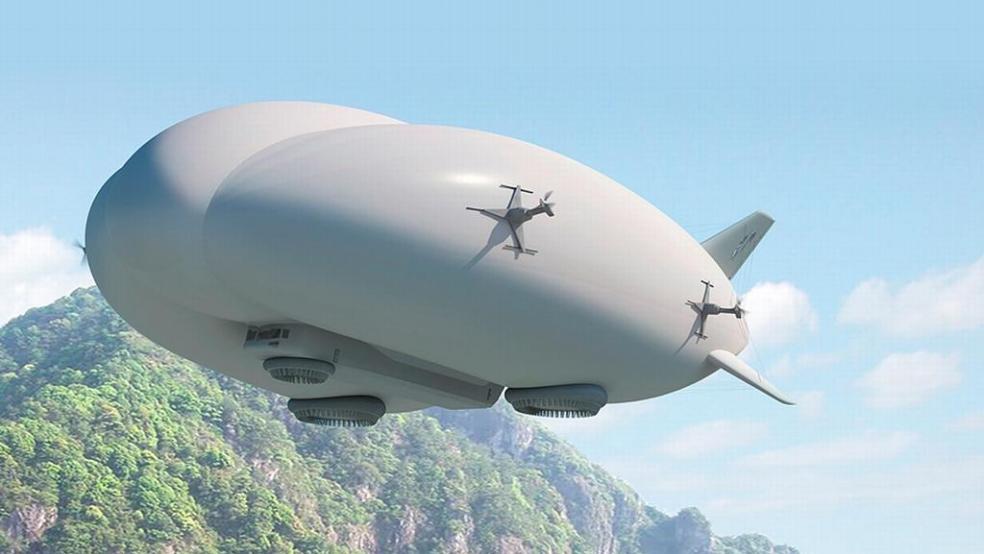"Airships, by the very laws of physics, are the most efficient and beautiful aircraft to ever fly," said Grant Cool.
The Canadian fixed-wing pilot was sitting in the mock-up of a blimp gondola built by a Hollywood set designer nestled in the middle of one of the most secretive places in America: Lockheed Martin's legendary Skunk Works, where the SR-71 was created, along with the F-117 stealth fighter.
Related: Move Over, F-35: Russia Has Raised the Stakes for Next-Generation Fighters
Cool originally came to Lockheed as a potential customer for the company's new Hybrid Airship, called the LMH1. The airship looks a bit like a flying can of Pillsbury Biscuits after it's been popped, and it can best be described as part blimp, part airplane and part helicopter. "We're getting a lot of interest for this, so we think there's going to be a market," said Bob Boyd, Lockheed's program manager for hybrid air systems.
That market is to deliver cargo to remote areas without roads, whether it's oil and gas exploration, mining projects or villages needing UPS deliveries from Amazon. No one really knows how big the market could be because this is new territory.
It's also new territory for Lockheed Martin.
While Cool may have come to Lockheed as a customer, he stayed. Cool is now chief operating officer for hybrid enterprises, an arm the company created to sell the airships to the commercial market.
You read that right. Lockheed Martin's top secret development facility has created an aircraft for the commercial market and started a sales department. "From what I understand, it is totally unique," Cool said.
The LMH1 will cost $40 million and carry 47,000 pounds of cargo along with 19 passengers. It will measure 300 feet long and almost 80 feet high, buoyed by non-flammable helium. Extra lift is created by its unusual tri-lobe shape which gives it aerodynamics similar to an airplane. Finally, four external 300-horsepower diesel engines rotate to move the craft forward or back, up or down.
Lockheed Martin has self-funded the entire project at a cost of more than $100 million.
Related: The F-35 Stumbles Again as Test Chief Find a New Weakness: Cyberattacks
The Hybrid Airship is a project more than a decade in the making. Ten years ago, Lockheed flew a smaller prototype, called the P-791. In classic Skunk Works fashion, it didn't tell anyone a test flight was coming, but no one driving through Palmdale, California, that morning could miss it ("We probably should have told the CHP," one official confided).
Over the next decade, the company tried to figure out a market for the product. It finally settled on commercial cargo to remote areas. Cool thinks the biggest market could end up being consumer goods.
"I mean, I've been to Central Africa, and there's people with cellphones using Google," he said. "What they don't have is access to the goods and services that the rest of the world has."
There are huge risks. Commercial airships haven't really gotten off the ground as an industry, beyond blimp advertising over football games. Lockheed is also facing competition. Companies such as Aeroscraft and Hybrid Air Vehicles are building their own airships, but Lockheed believes it will hit the market first. New FAA certification rules have been developed for the LMH1, and Lockheed hopes to have the first approved production models flying by late 2018.
The LMH1 will land on three cushions that can suction to the surface. It can also merely hover as cargo is moved, even over open water. It will fly below 10,000 feet, where the air is denser and can provide more lift. Maximum speeds will be 75 to 80 miles an hour, "faster than a ship." On a full cargo load at full speed, Boyd said the LMH1 can go at least 1,400 miles, "But if you slow down, you can go a lot farther." How far? "You actually go all the way around the planet ... on one tank of gas."
Related: Putin Sends Russia’s Deadly New Fighter Jet to Syria
One of the unique things about the LMH1 is that is intentionally heavier than air. Cool said this is important when your goal is to load and unload cargo. "We start with a very heavy vehicle that will sit safely on the ground, and then figure out the flight components after that," he said.
The company said that flying the airship will be cheaper and quieter than traditional aircraft, and the plan is to sell between 200 and 500 of them. If the LMH1 succeeds, bigger airships will follow, some the size of the Rose Bowl. "Eventually we hope to get something that maybe is as much as a million pounds of cargo, and at that scale the cost goes down, so we get significantly more competitive," said Boyd.
Initial sales will be directly to customers, but the company believes that in the future it will sell the airships to leasing companies, much in the same these companies lease aircraft to airlines. The first sales should be announced in a few weeks. Even as commodities prices have collapsed, Lockheed said potential clients in oil, gas and mining are thinking 10 to 20 years out, and they see airships as a way to save upfront infrastructure costs. However, some of these locations are in dangerous areas of the world. Boyd said the LMH1 can survive bullet holes. "It doesn't pop like a balloon ... we are still a military contractor, so we do know how to do defensive systems."
But as Lockheed faces a shrinking defense environment — it announced 1,000 voluntary buyouts across its aeronautics division this week — the people at Skunk Works are getting outside their comfort zone to sell to a market which has nothing to do with the Pentagon. "Yeah, we're not used to doing things like this," laughed Bob Boyd, "talking to the media."
This piece originally appeared on CNBC. Read more at CNBC:




